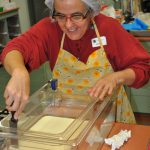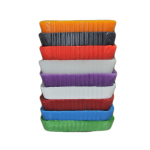There are many famous cheeses around the world that have ash added to them. Sainte Maure, Morbier, Valencay, Selles ser Chur, plus local cheese’s such as Meredith Ashed Chevre and Yarra Valley ashed pyramid are just a few. But why is ash added to these cheeses? It is tasteless and odorless!
For thousands of years ash was used as a preservative, to stop lumber from rotting, bodies from decomposing, preserving food and water on long sea voyages, filtering muddy water, controlling odours and as a powerful medicine.
Cheese also needed to be preserved especially as there was no refrigeration or the advantages of modern packaging. Originally ash was obtained from burning oak branches, grape vines or local timbers. The ash was sprinkled on the surface of the cheese often in conjunction with salt.
There are five main reasons why ash was added to the surface of the cheese:
1. To decrease the acidity of the cheese. Where the cheese has a high acidity such as fresh acid cheeses (cheese made without the use of or minimal use of rennet; most of the cheeses mentioned above are this style) the ash will neutralize the surface acidity. The surface flora required of those cheeses, some added to the milk and some occurs naturally, do not grow well in very acid environments but will grow earlier than would be expected if ash is added and results in a more complex micro flora of the final cheese. The ash in this situation also restricts the growth of unwanted micro flora
2. To absorb surface moisture. The surface moisture reduces the hardness of the rind. The rind is the hardened surface of the cheese and is important to protect the cheese inside from drying and physical damage. So if moisture is soaked up soon after manufacture then the hardened rind will be able to preserve and protect the interior of the cheese
3. The addition of salt in conjunction with the ash also aids in assisting points 1 & 2 above
4. Purely cosmetic. With modern packaging and refrigeration and controlled environments the need for ash to preserve the cheese is reduced or not even required.
5. Tradition. Tradition does not need to be lost just because of modern technology. This ash has been used for centuries and is as much as a characteristic of the cheese as the cheese itself. We need to these traditions to be preserved plus the ash is an instantly identifiable characteristic of those cheeses.
Ash is technically known as Activated Charcoal. The word “carbon” comes from the Latin word for coal. Graphite, the most thermodynamically stable form of carbon (as in pencil “lead”) is in the ash family as is the diamond.
Charcoal from burning wood in the back yard is not “activated charcoal”; rather it is a raw material for the manufacture of activated charcoal. Commercially cheesemaking ash it is derived from wood, sawdust / wood chip, coconut shells, bamboo and peat. For food grade purposes these timbers are heated to between 600 °C – 1,200 °C which is much higher than a conventional fire or oven can achieve.



